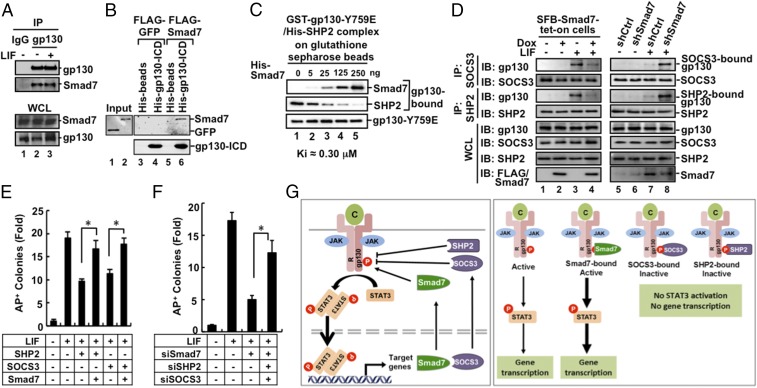Fig. 5.
Smad7 directly competes with SHP2/SOCS3 for gp130 binding and enables STAT3 signaling in maintaining pluripotency. (A) Smad7 interacts with gp130 under physiological conditions. Immunoprecipitation and Western blot analysis were done as described in Supporting Information. (B) Smad7 directly interacts with gp130. In vitro binding was carried out with purified His–gp130–ICD and in vitro translated Smad7. Experimental details are described in Supporting Information. (C) Smad7 displaces SHP2 on gp130. Increasing concentrations of purified His–Smad7 proteins were added to the gp130Y759E–SHP2 complex, and followed by Western blot analysis with indicated antibodies. (D) Smad7 competes with endogenous SHP2 and SOCS3 for gp130 binding in CGR8 cells. Cell lysates were immunoprecipitated with anti-SOCS3 antibody or anti-SHP2 antibody. Cell culture, LIF treatment, immunoprecipitation, and Western blot analysis were done as indicated and described in Supporting Information. (Left) SFB–Smad7–tet-on cells treated with or without Dox; (Right) CGR8 cells with shCtrl and shSmad7. In the bottom blots, FLAG/Smad7 means the use of anti-FLAG in lanes 1–4 and anti-Smad7 in lanes 5–8. (E) Smad7 overcomes SHP2- or SOCS3-mediated suppression of ESC colony formation. CGR8 cell transfection and AP staining were performed as described in Supporting Information. The bar graph represents the fold change of numbers of uniform AP+ colonies in Fig. S6F. Data are shown as mean ± SEM; n = 3. *P < 0.05. (F) SiSmad7 inhibition of ESC self-renewal is reversed by simultaneous knockdown of SHP2 and SOCS3. Experiments and data analysis were done as described in Fig. 5E and Supporting Information. The bar graph represents the fold change of numbers of uniform AP+ colonies in Fig. S6H. Data are shown as mean ± SEM; n = 3. *P < 0.05. (G) A working model for Smad7 potentiating STAT3 activation. (Left) LIF and related cytokines (C) bind to the gp130 receptor complex. Receptor-associated JAK kinases phosphorylate STAT3 leading to STAT3 accumulation in the nucleus, where STAT3 controls expression of target genes, including Smad7 and SOCS3. SOCS3 and SHP2 bind to gp130 to inhibit STAT3 activation. Smad7 can compete for the gp130 binding, maintaining STAT3 activation. (Right) Active and inactive forms of the cytokine-receptor–gp130 complex are shown.

